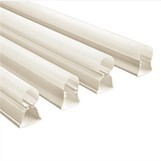What is the impact resistance of Modified ABS?
As a supplier of Modified ABS, I often encounter inquiries about the impact resistance of this remarkable material. Impact resistance is a crucial property that determines the suitability of a plastic for various applications, especially those where the material may be subjected to sudden forces or shocks. In this blog post, I will delve into the concept of impact resistance in Modified ABS, exploring its significance, the factors that influence it, and how it compares to other materials.
Understanding Impact Resistance
Impact resistance refers to a material's ability to withstand sudden forces or shocks without breaking, cracking, or deforming significantly. In the context of plastics, it is a measure of how well the material can absorb and dissipate energy when struck. High impact resistance is desirable in applications such as automotive parts, electronic enclosures, and consumer goods, where the material may be exposed to accidental drops, collisions, or other forms of mechanical stress.
Factors Affecting the Impact Resistance of Modified ABS
Several factors influence the impact resistance of Modified ABS. Understanding these factors can help in tailoring the material to meet specific application requirements.
Rubber Modification
One of the most common ways to improve the impact resistance of ABS is through rubber modification. By adding rubber particles to the ABS matrix, the material's ability to absorb energy is enhanced. The rubber particles act as stress concentrators, absorbing and dissipating the energy from an impact, thereby preventing crack propagation. Different types of rubber, such as styrene-butadiene rubber (SBR) and acrylonitrile-butadiene rubber (NBR), can be used for this purpose, each offering unique properties and performance characteristics.
Molecular Structure
The molecular structure of ABS also plays a significant role in its impact resistance. ABS is a terpolymer composed of acrylonitrile, butadiene, and styrene. The ratio of these monomers and the way they are arranged in the polymer chain can affect the material's mechanical properties, including its impact resistance. For example, increasing the butadiene content generally improves the impact resistance, as butadiene provides the rubbery phase that absorbs energy.
Processing Conditions
The processing conditions during the production of Modified ABS can also influence its impact resistance. Factors such as temperature, pressure, and shear rate can affect the dispersion of the rubber particles in the ABS matrix and the orientation of the polymer chains. Optimal processing conditions are essential to ensure uniform distribution of the rubber particles and to achieve the desired mechanical properties.
Additives
In addition to rubber modification, various additives can be used to further enhance the impact resistance of Modified ABS. These additives include impact modifiers, lubricants, and stabilizers. Impact modifiers are specifically designed to improve the material's ability to absorb energy, while lubricants can reduce friction during processing, improving the flow properties of the material. Stabilizers help to protect the material from degradation due to heat, light, and oxygen, ensuring long-term performance.
Comparing the Impact Resistance of Modified ABS with Other Materials
Modified ABS offers several advantages over other materials in terms of impact resistance. Compared to general-purpose plastics such as polystyrene (PS) and polycarbonate (PC), Modified ABS typically has higher impact resistance at a lower cost. It also has better chemical resistance and dimensional stability than some other plastics, making it suitable for a wider range of applications.
When compared to metals, Modified ABS has the advantage of being lightweight, which can reduce the overall weight of the product and improve fuel efficiency in automotive applications. It also offers better corrosion resistance than many metals, eliminating the need for additional surface treatments.
Applications of Modified ABS Based on Impact Resistance
The high impact resistance of Modified ABS makes it suitable for a wide range of applications across various industries. Some of the common applications include:
Automotive Industry
In the automotive industry, Modified ABS is used for interior and exterior parts, such as bumpers, dashboards, door panels, and trim. These parts are often subjected to impacts during normal use or in the event of a collision, and the high impact resistance of Modified ABS ensures their durability and safety.


Electronics Industry
In the electronics industry, Modified ABS is used for electronic enclosures, such as those for computers, televisions, and mobile phones. These enclosures protect the internal components from damage due to impacts and provide a stylish and functional exterior.
Consumer Goods Industry
In the consumer goods industry, Modified ABS is used for a variety of products, such as toys, sports equipment, and household appliances. The high impact resistance of Modified ABS makes these products more durable and resistant to damage, ensuring a longer lifespan.
Conclusion
In conclusion, the impact resistance of Modified ABS is a crucial property that makes it a versatile and widely used material in various industries. By understanding the factors that influence its impact resistance, such as rubber modification, molecular structure, processing conditions, and additives, we can tailor the material to meet specific application requirements. Whether you are looking for a lightweight and durable material for automotive parts, a protective enclosure for electronic devices, or a long-lasting consumer good, Modified ABS is an excellent choice.
If you are interested in learning more about our Reinforced Modified ABS, Flame Retardant ABS, or General Grade ABS, or if you have any specific requirements for your application, please feel free to contact us for a detailed discussion. We are committed to providing high-quality Modified ABS products and excellent customer service.
References
- "Plastics Engineering Handbook of the Society of Plastics Engineers" by Myer Kutz
- "Polymer Science and Technology" by Joel R. Fried
- "Handbook of Thermoplastics" by O. Olabisi




